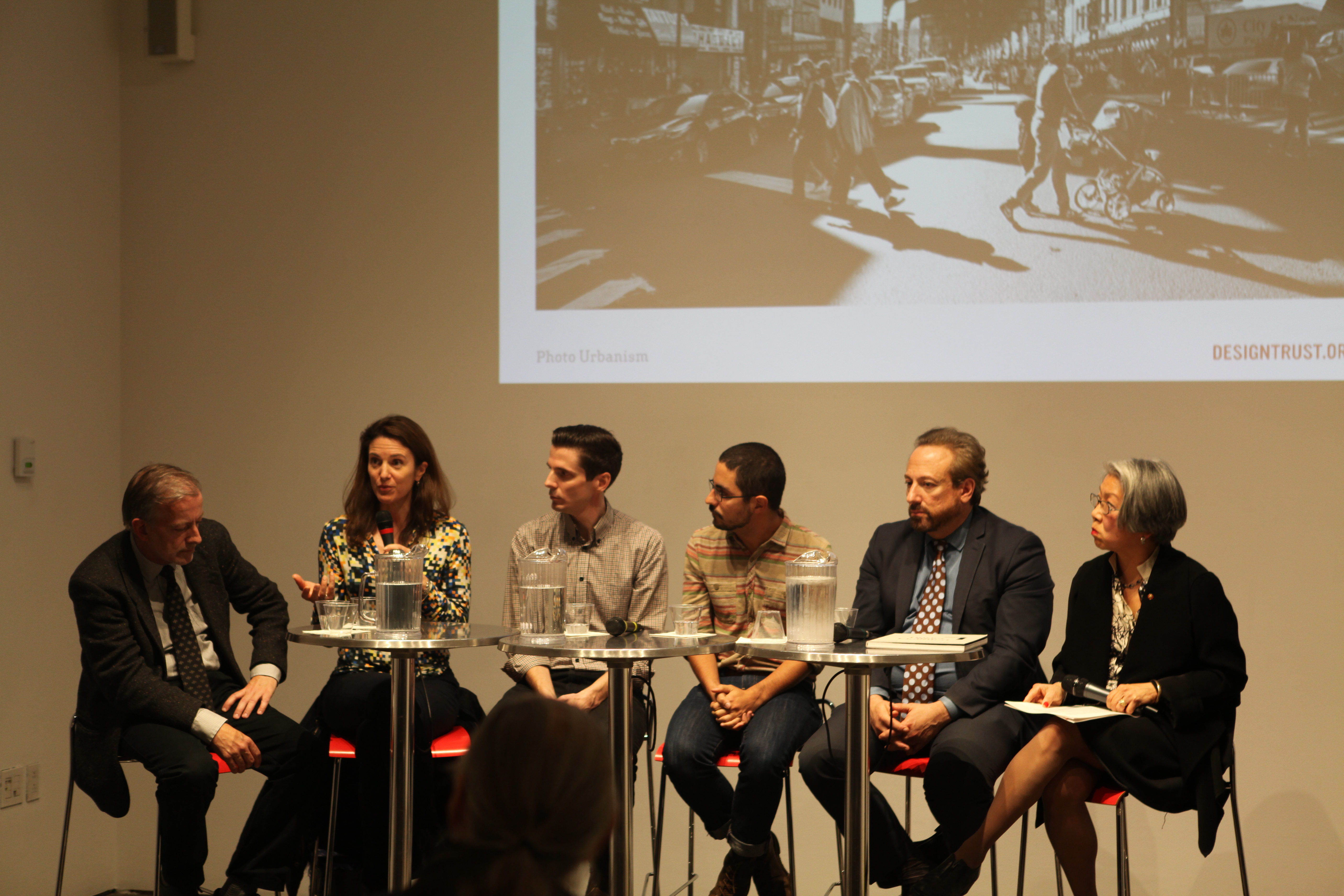by: ac
October’s Oculus Book Talk on 10.29.15 was introduced by the Center for Architecture’s Managing Director Cynthia Kracauer, AIA, LEED AP, who acted as a lovely town crier for the lively programming at the Center and its brand new South Street Seaport location. She was followed by a panel discussion moderated by Design Trust Executive Director Susan Chin, FAIA, Hon. ASLA, with the most recent Design Trust Fellows: Douglas Woodward, Policy Fellow; Susannah Drake, AIA, FASLA, Urban Design Fellow; Neil Donnelly, Graphic Design Fellow; Chat Travieso, Participatory Design Fellow; and Neil Gagliardi, Director of Urban Design at the NYC Department of Transportation.
Chin gave an insightful prologue to the Design Trust’s Under the Elevated Project. She then asked the panel well-crafted questions. Her first was the most surprising and delightful, querying graphic designer Donnelly as to why a printed artifact might be of value in such a high-stakes discussion. The subsequent conversation was revelatory in illustrating the gravitas of developing a culture of attention to details and “specialness” (insight imparted by the DOT’s Gagliardi), as well as concluding that a web platform could not support the depth of the content. The Design Trust fellows explained the team’s actual work was embedded in Donnelly’s graphic organization. Indeed, the book is an honest appraisal of an urbanist’s methodology. It was so refreshing to be at a book talk about books, rather than theoretical content that can be only expressed in books.
The artifact the Design Trust has developed, Under the Elevated: Reclaiming Space, Connecting Communities, is a disarmingly handsome object. Donnelly’s self-described “book nerd” ethos serves the project well. The organization of the material is clear – project to policy distinctions are elegantly obvious. There are two diagramming exercises that stand out. First are the delicate axonometric drawings of the elevated spaces that identify the varied agencies that have jurisdiction over different portions of the site. For instance, for the highly successful Division Street project, there were no less than six city agencies that could impact the design proposal. This kind of transparency is of tremendous value to the design community. The second, more organizational concept is the “Pop-up to Pilot to Permanent” section. This chapter, which conveys the project’s progression, will serve other communities that the Design Trust might engage in an honest and productive manner.
The introductory essay by Thomas J. Campanella puts forward just the right ratio of skeptical-to-romantic tone. He gives the reader a series of cultural touchstones: the Brooklyn Dodgers name derives from the harrowing game of chicken 19th-century youths would play amongst the elevated rail structures; painters and film makers have been caught up in the danger and voyeurism of the infrastructure’s consequences. He describes many an artist’s relationships to the Elevated’s quality of light, and how it has mapped the city dweller’s experience. Cocooned by Krisanne Johnson’s tough and earnest images of contemporary street life under the Elevated, this introduction to the “L-space” ignites the urban imagination.
The word “imagination” is key to the Design Trust’s work. Chin highlighted imagination as a paramount directive for the The L Space project. Most of the proposals in this collection are bright, assertive, and master a level of innovation that only the New York design community can bring forth. The downfall of this collection is that when a project is undercooked or not as thoughtful, it is very evident. Any solution other than a Susannah Drake landscape proposal or the smart integration of music and culture in the Bronx Boogie Box project feels weak and disappointing; the proposal for the Hamilton Avenue Pedestrian Corridor is the most obvious example.
The Under the Elevated project and the Design Trust Fellows Program add critical points to the discussions melding design and community engagement – primarily, beauty works.
Event: Oculus Book Talk: Under the Elevated: Reclaiming Space, Connecting Communities
Location: Center for Architecture, 10.29.15
Speakers: Susan Chin, FAIA, Hon. ASLA, Executive Director, Design Trust for Public Space; Neil Gagliardi, Director of Urban Design, NYC Department of Transportation; Design Trust Fellows Douglas Woodward, Policy; Susannah Drake, AIA, FASLA, Urban Design; Neil Donnelly, Graphic Design; and Chat Travieso, Participatory
Organized by: AIANY Oculus Committee and Design Trust for Public Space









